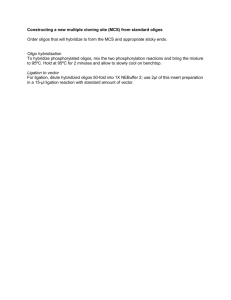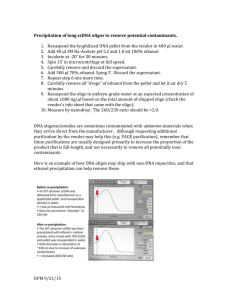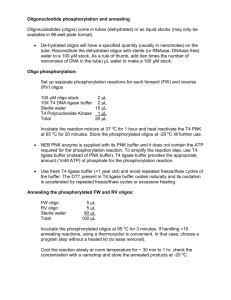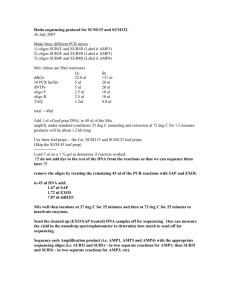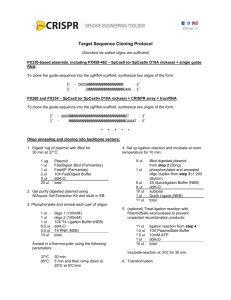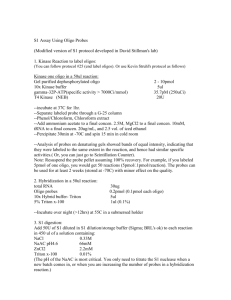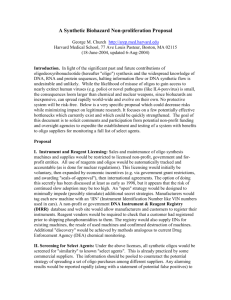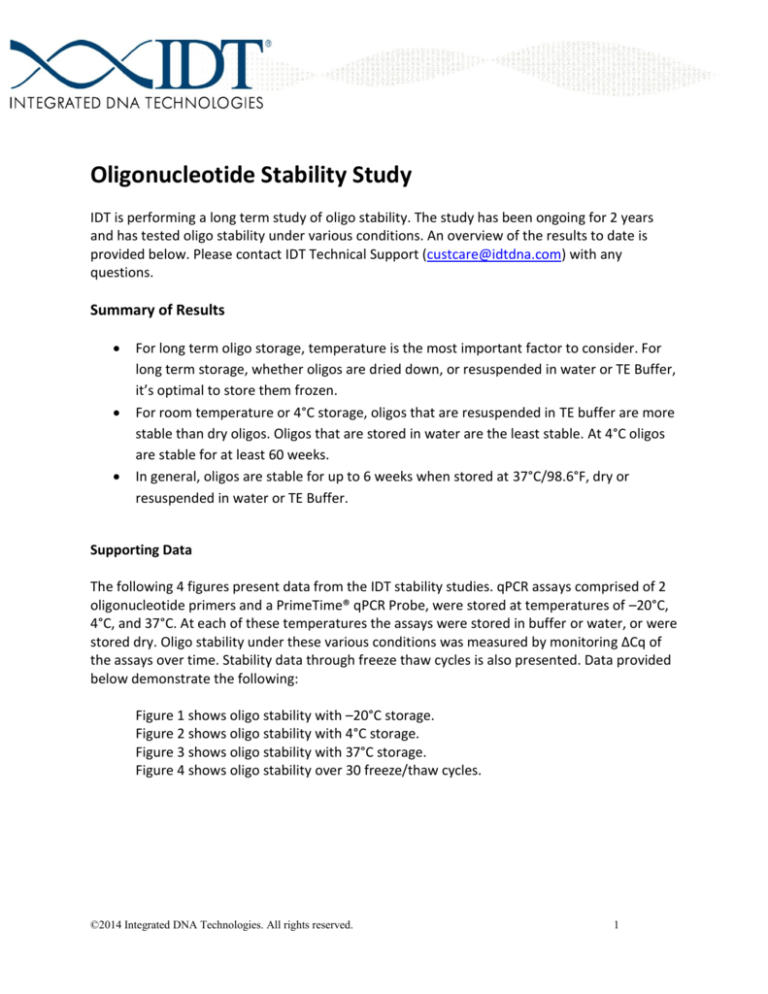
Oligonucleotide Stability Study
IDT is performing a long term study of oligo stability. The study has been ongoing for 2 years
and has tested oligo stability under various conditions. An overview of the results to date is
provided below. Please contact IDT Technical Support (custcare@idtdna.com) with any
questions.
Summary of Results
For long term oligo storage, temperature is the most important factor to consider. For
long term storage, whether oligos are dried down, or resuspended in water or TE Buffer,
it’s optimal to store them frozen.
For room temperature or 4°C storage, oligos that are resuspended in TE buffer are more
stable than dry oligos. Oligos that are stored in water are the least stable. At 4°C oligos
are stable for at least 60 weeks.
In general, oligos are stable for up to 6 weeks when stored at 37°C/98.6°F, dry or
resuspended in water or TE Buffer.
Supporting Data
The following 4 figures present data from the IDT stability studies. qPCR assays comprised of 2
oligonucleotide primers and a PrimeTime® qPCR Probe, were stored at temperatures of –20°C,
4°C, and 37°C. At each of these temperatures the assays were stored in buffer or water, or were
stored dry. Oligo stability under these various conditions was measured by monitoring ∆Cq of
the assays over time. Stability data through freeze thaw cycles is also presented. Data provided
below demonstrate the following:
Figure 1 shows oligo stability with –20°C storage.
Figure 2 shows oligo stability with 4°C storage.
Figure 3 shows oligo stability with 37°C storage.
Figure 4 shows oligo stability over 30 freeze/thaw cycles.
©2014 Integrated DNA Technologies. All rights reserved.
1
Figure 1. Oligo Stability with –20°C
Storage. This data measures stability of
oligos used in a qPCR assay based on the
∆Cq of the assay over time. At a time
point of 24 months, oligos stored frozen
remain intact (∆Cq has remained less
than a 1.5 Cq rise). There is no
significant difference in stability at this
storage temperature whether storing
oligos in TE buffer, water, or dry.
Figure 2. Oligo Stability with 4°C Storage.
This 4°C study has been performed out to 60
weeks. While the method of storage at this
temperature appears to have a small effect
of on oligo stability, this difference is
statistically insignificant. At 60 weeks, all
oligos appear stable across all storage
methods tested.
Figure 3. Oligo Stability with 37°C
Storage. In this accelerated study, oligos
were kept at 37°C (98.6°F). A clear
distinction can be seen between oligos
stored in water, TE buffer (IDTE), or dry.
Resuspension in TE buffer provides the
greatest oligo stability, followed by
storing the oligo dry. Storage in water
provides the least stability.
©2014 Integrated DNA Technologies. All rights reserved.
2
0 Freeze-Thaws
15 Freeze-Thaws
30 Freeze-Thaws
Panel A. qPCR
Resulting
Amplification
qPCR Amplification
Curves forCurves
Assaysfrom
XXXX.
Oligos Treated with 0–30 FreezeThaw Cycles.
0 vs 30 Freeze-Thaws;
Rn vs Cycle
Panel B. Comparison of qPCR Assays Treated with 0 vs 30 Freeze-Thaw Cycles.
Figure 4. Oligos Stability Over 30 Freeze/Thaw Cycles. (A) A standard scale IDT
PrimeTime® qPCR Assay, containing oligonucleotide primers and probe, was hydrated in
IDTE (TE buffer from IDT) to 40X. The tube was frozen (−20°C) and thawed 30 times. At
0, 15, and 30 freeze−thaw cycles, an aliquot of the assay was run against a validated
universal human reference cDNA standard curve (0.005−50 ng) using TaqMan® Gene
Expression Master Mix (Applied Biosystems). (B) The PrimeTime qPCR Assays at 0.5 ng
cDNA concentration in a ROX™-normalized view (Rn). The oligonucleotide components
of the PrimeTime qPCR Assays were functional, showing no impact on Cq value for up
to 30 freeze−thaw cycles.
©2014 Integrated DNA Technologies. All rights reserved.
3
Frequently Asked Questions
Short term stability
My oligo was left out at room temperature in the receiving department (or at the UPS
warehouse) over the weekend; is it still okay to use?
The oligo is still OK to use. IDT has tested oligo stability during shipping conditions by
storing oligos at a temperature of 37°C (98.6° F). At this temperature oligos are stable
for up to 6 weeks regardless of whether they are stored in water, buffer, or dry. Dry
oligos are stable at this temperature significantly longer than 6 weeks. The 37°C
temperature was chosen as a worst-case scenario for standard shipping conditions (see
Figure 3 above).
My oligo was left out at room temperature on the counter over the weekend (or a
freezer went down for a few days); is it still ok to use?
IDT has tested oligos under what we consider worst-case scenario conditions— a
constant 37°C—to represent oligos delayed in transit or left out of the freezer for a
period of time. We have found that oligos stored in water at 37°C were stable for 6
weeks. Oligos stored dry or in buffer were stable for even longer periods of time.
Long term stability
How should I store my oligo?
For optimal stability, oligos that are to be stored long term should be stored frozen, at 20°C. If the oligos are going to be resuspended, storage in a TE buffer (for example,
IDTE) is better than using water. The impact from the type of storage medium used is
marginal at -20°C, but becomes more important at higher temperatures (see Figures 1–3
above). It is ideal to store oligos in the dark. Exposure to UV light should be avoided, and
ambient lab light should be minimized, particularly for some types of modified oligos.
Why is freezing in TE buffer recommended over storing oligos dry?
It’s important to remember that ‘dry’ oligos always have some level of moisture present,
and are never actually completely dry. This is one of the contributing reasons for why
resuspension in TE buffer provides a more stable long-term storage method compared
to oligos stored dry.
©2014 Integrated DNA Technologies. All rights reserved.
4
However, oligos stored dry, or in water for that matter, are very stable for the short
period of time it takes to ship an oligo. IDT ships its oligos dry to provide the researcher
complete control over the reagents they want to use for resuspension.
What is the shelf life of this oligo?
The shelf life of an oligo is dependent on the temperature at which the oligo is stored,
and how the oligo is resuspended. Temperature is the more important of the 2
variables. Generally, oligos should be stored at –20°C. At this temperature an oligo has
a minimum shelf life of 2 years, whether it is stored dry, in TE buffer, or in water.
Is my oligo still good after X amount of time has gone by?
This will depend on the way the oligo has been stored. Our on-going stability study
addresses oligos stored at –20°C, 4°C, and 37°C. Please see the summary information at
the top of this document.
Do freeze/thaw cycles affect oligo stability?
IDT has functionally tested oligo stability after up to 30 freeze/thaw cycles. These oligos
were stored in both water and TE buffer. We have not found a significant impact on
oligo function over the course of these 30 freeze/thaw cycles (see Figure 4 above).
Considerations beyond standard unmodified DNA
What is the stability of RNA vs. DNA?
RNA is inherently less stable than DNA due to its chemical structure. Additionally RNases
are more prevalent in standard laboratory conditions than DNases. As even the
slightest exposure to RNase can impact RNA stability, IDT has not performed rigorous
long term stability studies for RNA.
Should RNA be stored differently than DNA?
The inherent chemical structure of RNA makes it less stable than DNA. RNases that
degrade RNA are also more prevalent than DNases. As RNA is a great deal more
sensitive to degradation compared to DNA, for short term storage we recommend using
a neutral to slightly acidic buffer containing a chelator. However, RNA is most stable
©2014 Integrated DNA Technologies. All rights reserved.
5
when stored as an ethanol precipitate at –80°C, especially when storing RNA oligos long
term. The biggest concern for RNA oligonucleotide storage is avoiding RNase.
Do modifications affect the stability or shelf life of oligos?
For the modifications tested at this point, the pattern of degradation seen for modified
oligos is similar to that for standard oligos. Studies are currently in progress with
selected modifications and further specific information will be available in the future.
Is there any information on the stability of fluorescently labeled oligos and the
fluorescent modifications?
The stability of fluorescently labeled oligos and fluorophore function is similar to the
stability of a standard oligo. With fluorophores, it’s important to remember that
exposure to light or ozone can negatively impact stability.
What is the shelf life and stability for other IDT products that aren't included in the IDT
Oligonucleotide Stability Study?
Our stability studies have been performed with sequences designed to represent a
practical range of the oligos we produce. It is important to remember that sequence
variations may impact stability. The only way to know the precise stability of a specific
oligo is to perform functional stability studies on that specific oligo.
What is the expiration date for an oligo?
If you are using an oligo for a commercial use or as a molecular diagnostics product,
please contact our Clinical and Commercial Accounts (mailto:GMPinfo@idtdna.com) or
Third Party Manufacturing (tpmi-solutions@idtdna.com) representative. These groups
can provide a letter containing expiration dates.
Can an expiration date be printed on the oligonucleotide tube label?
Yes, IDT can provide custom labels that include the oligo expiration date. Please contact
customquotes@idtdna.com for more information regarding the quotation process for
this service.
©2014 Integrated DNA Technologies. All rights reserved.
6

